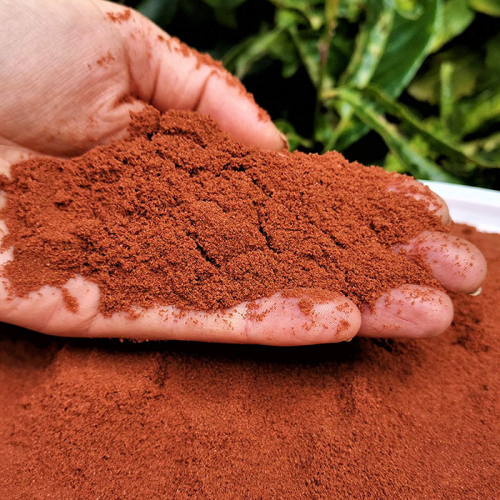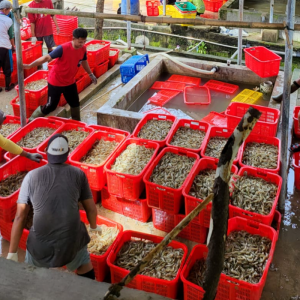
Potential of Astaxanthin in Resistance to Vibrio
| Thu, 12 Aug 2021 - 11:38
Potential of astaxanthin to act as a protective agent against oxidative stress, helping to increase resistance to Vibrio-induced disease in seabass.
Seabass has high nutritional value, is widely distributed and easy to raise, so it has become one of the selected objects to develop the main aquaculture industry in many countries in the region. However, in the rearing process, due to limitations in environmental management and care techniques, seabass farming is facing many outbreaks of diseases causing economic losses to farmers.
Fish disease with sores on the body with a rapid spread, causing about 80% of deaths within 1 week, the disease occurs in all sizes of farmed fish, from newly stocked fish to grown-up fish (2-3kg). The primary cause was determined to be caused by the bacterium Vibrio alginolyticus . Infected fish show signs of lethargy, bleeding at the base of the tail and widespread sores, fish at a young stage show anorexia, dark body color, then mass death.
Read more: Global Astaxanthin Market to Expand as Dietary Supplements Become a Part of Seafood Indusrty
Astaxanthin is a potent lipid-soluble marine keto-carotenoid with beneficial effects on human and animal health. More importantly, astaxanthin acts as a protector against oxidative stress through mechanisms such as radical scavenging and single-oxygen neutralization, and astaxanthin also plays an important role in the anti-inflammatory response through modulation of oxidative stress.
Regulates cytokine production, NF-κB signaling pathway and apoptotic pathways. Dietary astaxanthin supplementation has been shown to improve growth performance, antioxidant capacity and immune response of shrimp, crab and many fish species.
The aim of this study was to evaluate the effects of astaxanthin supplementation on growth performance, lipid metabolism, antioxidant capacity and immune response of seabass.
Fish with an average weight of 28 g were arranged in 4 treatments supplemented with astaxanthin (AX) at concentrations of 0, 50, 100, 150 mg/kg AX for 90 days and then challenged with V. Alginolyticus at the end of the feeding period to determine the potential effects of astaxanthin on the biochemistry, nonspecific immunity and disease resistance of seabass.
Read more: Marine Ingredients are Stable in Volume, Strategic in Aquaculture Nutrition
The results showed that fish had a significant improvement (P < 0.05) in hematological parameters (white blood cell count, red blood cell count, hemoglobin and hematocrit) when fed different diets with different diets. high doses of astaxanthin throughout the feeding periods.
Serum concentrations of alanine aminotransferase (ALT), aspartate aminotransferase (AST), glucose and cortisol in fish fed the supplemented diet decreased significantly (P < 0.05) as dietary intake increased. get a raise. Furthermore, the dietary supply of astaxanthin in increasing doses reduces serum cholesterol and triglycerides.
Immune parameters (respiratory flare activity, lysozyme activity, phagocytic activity and total serum immunoglobulin) of fish were significantly stimulated (P < 0.05) by astaxanthin supplementation.
After infection with V. Alginolyticus , astaxanthin supplementation treatments showed increased white blood cell [WBC] and red blood cell [RBC] counts, hemoglobin and hematocrit levels through the post-infection stages (0) , 7 and 14 days) and reached optimal values when supplemented with 100-150 mg/kg astaxanthin.
Read more: Macronutrient Research in Aquaculture Nutrition
Furthermore, dietary intake of astaxanthin markedly (P < 0.05) increased serum biochemical composition (aspartate aminotransferase [AST], alanine aminotransferase [ALT], glucose, cortisol, cholesterol and triglycerides) of fish after infection, thereby increasing the survival rate.
Fish supplemented with astaxanthin had much higher serum total protein (P < 0.05) than the control.
In addition, the immune defense mechanisms (lysozyme activity, phagocytic activity, respiratory burst activity and total serum immunoglobulin) of challenge fish were markedly stimulated (P < 0). ,05) after astaxanthin supplementation.
Besides, the addition of astaxanthin in the diet significantly increased (P < 0.05) the survival rate of fish after challenge. The fish in the treatment supplemented with 150mg/kg astaxanthin gave the highest rate of nearly 80% after 14 days of infection, much higher than the control.
Collectively, the results showed that astaxanthin supplementation was effective in enhancing fish immunity and disease resistance against V. Alginolyticus at an optimal dose of 100-150 mg/kg astaxanthin.
Source: tepbac.com






















